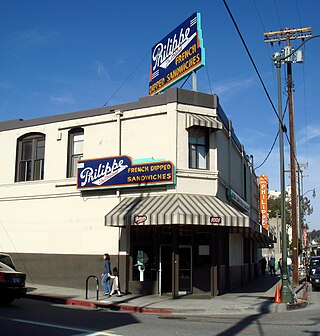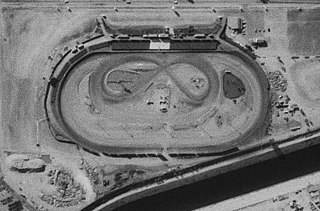Related Research Articles

Terminal Island, historically known as Isla Raza de Buena Gente, is a largely artificial island located in Los Angeles County, California, between the neighborhoods of Wilmington and San Pedro in the city of Los Angeles, and the city of Long Beach. Terminal Island is roughly split between the Port of Los Angeles and Port of Long Beach. Land use on the island is entirely industrial and port-related except for Federal Correctional Institution, Terminal Island.

Huell Burnley Howser was an American television personality, actor, producer, writer, singer, and voice artist, best known for hosting, producing, and writing California's Gold and his human interest show Visiting... with Huell Howser, produced by KCET in Los Angeles for California PBS stations. The archive of his video chronicles offers an enhanced understanding of the history, culture, and people of California. He also voiced the Backson in Winnie the Pooh (2011).

Philippe's, or "Philippe the Original" is a restaurant located in downtown Los Angeles, California. The restaurant is well known for continuously operating since 1908, making it one of the oldest restaurants in Los Angeles. It is also renowned for claiming to be the inventor of the French dip sandwich.

Riverside International Raceway was a motorsports race track and road course established in the Edgemont area of Riverside County, California, just east of the city limits of Riverside and 50 mi (80 km) east of Los Angeles, in 1957. In 1984, the raceway became part of the newly incorporated city of Moreno Valley. Riverside was noted for its hot, dusty environment, which was a dangerous challenge for drivers. It was also considered one of the finest tracks in the United States. The track was in operation from September 22, 1957, to July 2, 1989, with the last race, The Budweiser 400, won by Rusty Wallace, held in 1988. After that final race, a shortened version of the circuit was kept open for car clubs and special events until 1989.

Jefferson Park is a neighborhood in the South Los Angeles region of the City of Los Angeles, California. There are fourteen Los Angeles Historic-Cultural Monuments in the neighborhood, and in 1987, the 1923 Spanish Colonial Revival Jefferson Branch Library was added to the National Register of Historic Places. A portion of the neighborhood is a designated Historic Preservation Overlay Zone (HPOZ).

Ascot Park, first named Los Angeles Speedway and later New Ascot Stadium, was a dirt racetrack located near Gardena, California. Ascot Park was open between 1957 and 1990. The track held numerous United States Auto Club (USAC) national tour races and three NASCAR Grand National races. The Turkey Night Grand Prix was held at the track for several decades.

The Balboa Island Car Ferry is a ferry service in Newport Beach, California.

Figueroa Street is a major north-south street in Los Angeles County, California, spanning from the Los Angeles neighborhood of Wilmington north to Eagle Rock. A short, unconnected continuation of Figueroa Street runs just south of Marengo Drive in Glendale to Chevy Chase Drive in La Cañada Flintridge.

Located in the Historic Core of Downtown Los Angeles, the Old Bank District is a group of early 20th century commercial buildings, many of which have been converted into residential (loft) use. The Old Bank District is bordered roughly by the Jewelry District, the Fashion District, Gallery Row, the Toy District, and the city's Civic Center - specifically the block from Main to Spring streets between 4th and 5th.

The Fairplex has been the home of the L.A. County Fair since 1922. Known prior to 1984 as the Los Angeles County Fairgrounds, it is located in the city of Pomona, California. The L.A. County Fair is held during the month of May since 2022, but the facility is used year-round to host a variety of educational, commercial, and entertainment such as trade and consumer shows, conventions, and sporting events.

California has 21 major professional sports franchises, far more than any other US state. The San Francisco Bay Area has six major league teams spread amongst three cities: San Francisco, Oakland and San Jose. The Greater Los Angeles Area has ten major league teams. San Diego and Sacramento each have one major league team.

Willow Springs International Motorsports Park is located in Willow Springs near Rosamond, California, about 80 mi (130 km) north of Los Angeles. It is the oldest permanent road course in the United States. Construction began in 1952, with the inaugural race held on November 23, 1953. The main track is a 2.500 mi (4.023 km) long road course that is unchanged from its original 1953 configuration. The elevation changes and high average speeds make it a favorite of many road racing drivers.

Ralph J. Scott, also formerly known as Fireboat #2, is a 100-foot (30 m) fireboat that was attached to the Los Angeles Fire Department serving the Port of Los Angeles. She was retired in 2003 after 78 years and replaced by Warner L. Lawrence. Ralph J. Scott is undergoing restoration near the Los Angeles Maritime Museum in San Pedro. On 30 June 1989, she was listed as a National Historic Landmark. She is currently located at the Los Angeles Fire Department, Fire Station 112, at 444 South Harbor Blvd, Berth 86, San Pedro, California.

The historic Subway Terminal, now Metro 417, opened in 1925 at 417 South Hill Street near Pershing Square, in the core of Los Angeles as the second, main train station of the Pacific Electric Railway; it served passengers boarding trains for the west and north of Southern California through a mile-long shortcut under Bunker Hill popularly called the "Hollywood Subway," but officially known as the Belmont Tunnel. The station served alongside the Pacific Electric Building at 6th & Main, which opened in 1905 to serve lines to the south and east. The Subway Terminal was designed by Schultze and Weaver in an Italian Renaissance Revival style, and the station itself lay underground below offices of the upper floors, since repurposed into the Metro 417 luxury apartments. When the underground Red Line was built, the new Pershing Square station was cut north under Hill Street alongside the Terminal building, divided from the Subway's east end by just a retaining wall. At its peak in the 20th century, the Subway Terminal served upwards of 20 million passengers a year.

The Hollywood Subway, as it is most commonly known, officially the Belmont Tunnel, was a subway tunnel used by the interurban streetcars of the Pacific Electric Railway. It ran from its northwest entrance in today's Westlake district to the Subway Terminal Building, in the Historic Core, the business and commercial center of Los Angeles from around the 1910s through the 1950s. The Subway Terminal was one of the Pacific Electric Railway’s two main hubs, the other being the Pacific Electric Building at 6th and Main. Numerous lines proceeded from the San Fernando Valley, Glendale, Santa Monica and Hollywood into the tunnel in Westlake and traveled southeast under Crown and Bunker Hill towards the Subway Terminal.

Pershing Square is a small public park in Downtown Los Angeles, California, one square block in size, bounded by 5th Street to the north, 6th Street to the south, Hill Street to the east, and Olive Street to the west. Originally dedicated in 1866 by Mayor Cristóbal Aguilar as La Plaza Abaja, the square has had numerous names over the years until it was finally dedicated in honor of General John J. Pershing in 1918.

Whittier Boulevard is an arterial street that runs from the Los Angeles River to Brea, California. The street is one of the main thoroughfares in both Whittier and East Los Angeles. At various times, portions of Whittier Boulevard carried the designation of U.S. Route 101. Whittier Boulevard also carries a portion of El Camino Real. Its west section leading from the Sixth Street Viaduct was demolished in 2016; the replacement was officially opened in 2022.. Currently, Whittier Boulevard carries two Caltrans controlled highways. The portion between Rosemead Boulevard and Beach Boulevard carries State Route 72 and the portion between Beach and Harbor Boulevards carries California State Route 39. The portion of State Route 72 up to State Route 19 was relinquished back to Pico Rivera in the early 2000s and the portion of State Route 72 between State Route 19 and Downey Road was deleted from SR 72 in 1992.
The Lindbergh Beacon, an aircraft beacon atop the Los Angeles City Hall, operated nightly from April 26, 1928, until just after the attack on Pearl Harbor. It was restored to its original condition in 2001, and Los Angeles magazine described it as "a tiara of light atop our beautifully restored Los Angeles City Hall." City officials now occasionally put the beacon into operation for special occasions such as the year-end holidays.

"Big Willie" Robinson was an American street racer, bodybuilder, and president of the International and National Brotherhood of Street Racers. He was active in the street racing community in Los Angeles, especially in the 1960s and 1970s, where he gained attention of the Los Angeles Police Department, the local media, and politicians. The Watts riots led to Robinson using drag racing as a method of addressing street violence fueled by racial tensions and police violence. He married fellow street racer Tomiko Robinson in the late 1960s, who became an integral part of the street racing community until her death in 2007. With the support of Los Angeles mayor Tom Bradley, Robinson founded Brotherhood Raceway Park in 1974 and the dragstrip maintained a presence on Terminal Island until 1994. Robinson died in 2012.

Virgil Village is a neighborhood in Los Angeles, California.
References
- 1 2 Martin, Zach (July 19, 2019). "Behind the Telling of Big Willie Robinson's Story".
- ↑ Dennis McLellan (25 May 2012). "'Big Willie' Robinson dies at 69; L.A. drag race organizer". Los Angeles Times .
- ↑ "LA Harbor Department Files Reveal Tension With Big Willie Robinson". www.documentcloud.org. Retrieved 2024-05-10.
- ↑ Miller, Daniel (2019-07-30). "After riots again engulf L.A. in 1992, Big Willie Robinson plots a comeback". Los Angeles Times. Retrieved 2024-05-10.
- ↑ "Otis Chandler Advocates for Big Willie Robinson". www.documentcloud.org. Retrieved 2024-05-10.
- ↑ Daniel Strohl (31 December 2014). "Los Angeles street racers aim to bring drag racing back to Terminal Island". Hemmings Motor News .
- ↑ "Outer Harbor | Multi-Use Terminal | Port of Los Angeles". www.portoflosangeles.org. Retrieved 2024-05-10.
- ↑ "Brotherhood Raceway- Visiting (318) – Huell Howser Archives at Chapman University".
- 1 2 3 4 Miller, Daniel (2019-07-16). "Big Willie Robinson's wild Hollywood ride: 'Star Wars,' 'Fast & Furious' and Paul Newman". Los Angeles Times. Retrieved 2024-05-03.